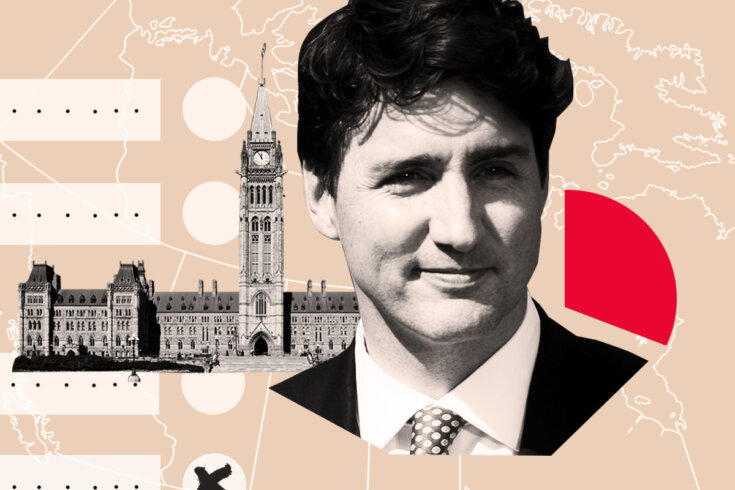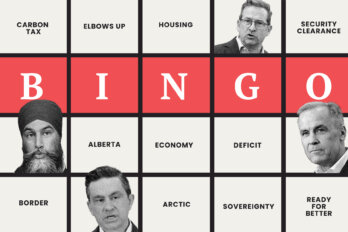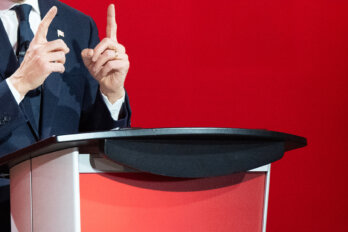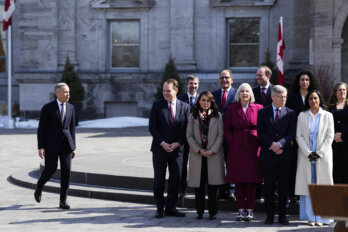Listen to an audio version of this story
For more audio from The Walrus, subscribe to AMI-audio podcasts on iTunes.
In the early morning of September 21, soon after the television networks called a Liberal minority government, David Herle, a Liberal election strategist not involved in the campaign, tweeted, “If I’d known you could win an election with 31% we’d have done it in 2006.” Herle was making a joke about his painful memories helping run Paul Martin’s 2006 campaign, which ended with Martin picking up 30.2 percent of the vote and getting trounced by Stephen Harper, who received 36.3.
Fifteen years later, Herle watched Justin Trudeau, without collecting many more votes than Martin had, walk away with a decisive victory. A week later, after the mail-in ballots were counted, we learned that Trudeau’s vote percentage was actually 32.6, enough to elect 159 Liberal MPs. The Conservatives edged past—with 33.7 percent—but that gave them only 119 MPs. For the second election in a row, the Tories lost the election but won the popular vote. Also noteworthy: both parties had a smaller percentage of the vote than in previous elections.
Globe and Mail columnist Andrew Coyne pointed out this trend in a series of tweets illustrating the steadily declining share of the vote that governing parties have won over the decades, as the two big-tent parties have been forced to share the electorate not just with the NDP and the Bloc Québécois but also with upstarts like the Greens and the People’s Party.
Gerald Butts, Trudeau’s former top adviser, responded by suggesting that the Liberals ought to be congratulated for figuring out how to win with fewer votes, a process he called vote efficiency. Butts was referring to the way campaigns today can build a viable electoral coalition by using data to maximize the voter turnout in battleground ridings. This can allow them to ignore places where they are unlikely to win and crank up the pressure in ridings where they’re competitive. “We count seats, not votes, so smart campaigns focus on delivering them,” he tweeted. In Canada—as in the United Kingdom and most Commonwealth countries—citizens vote for MPs, not directly for the leader. That means, to win an election, leaders need to worry about the number of MPs elected, not the total vote.
Butts tweeted that the last three Trudeau Liberal campaigns were among “the most efficient” in Canadian history, and he praised the “super geniuses” of Data Sciences, a Montreal-based analytics firm that handles voter identification, getting out the vote, and digital advertising for the Liberal party and local campaigns across the country.
Optimizing votes is now a core political strategy in North America. (Barack Obama used it to great effect to win both of his presidencies.) But it being routine didn’t make the tactic any easier to swallow for advocates of Canadian electoral reform, which Trudeau promised during his 2015 election campaign and then failed to deliver. Fair Vote Canada is a group that wants to change the country’s current first-past-the-post voting system and bring in proportional representation—a system that would make it impossible for any government to be elected with 32.6 percent of the vote and would result in a Parliament that more accurately represents the vote share won by different parties. Sharon Sommerville, who was until recently Fair Vote Canada’s media spokesperson, found Butts’s celebration of voter efficiency vexing because she sees the Liberals as cynically gaming an electoral system they refuse to fix. “Everybody in the country knows this election was a power grab,” she says, referring to the theory that Liberals sent Canadians to the polls in a gamble for a majority. “And, when you know that they were using these very sophisticated marketing tools to strategize and target voters, it leaves such a bad taste in your mouth.”
The Liberals, of course, fell short of that majority. And, while minority governments aren’t new, what is new is the diminishing share of the national vote held by a winning party, which produces election results based on wafer-thin margins in close ridings. Questions about whether the technological methods that deliver such results belong in a democratic system are to be expected, but if modern parties want to succeed, they have no choice but to use them.
Tom Pitfield—son of senior civil servant Michael Pitfield, who, among other things, helped Pierre Trudeau repatriate the Constitution—is the CEO of Data Sciences and has worked in elections across Canada and in France, Norway, and the UK. His wife, Anna Gainey, daughter of hockey great Bob Gainey, was elected president of the Liberal party in 2014. (She stepped down in 2018.) Along with Katie Telford and Butts, they were part of a tight-knit group that managed to put Trudeau in the Prime Minister’s Office.
When they started, in 2014, the Liberals’ data operation had been lagging behind the Conservatives’ for years—“They were light years ahead of us,” says Herle. The 2021 election demonstrated that Data Sciences has more than closed the gap. The election has also given Canadians a new look at the mathematical ruthlessness with which political campaigns are now run. According to Pitfield, legislated spending caps have forced parties in Canada to look at the electoral map strategically and figure out which seats they need to win. “The whole game plan since 2015 is to be agile and to deploy limited resources as efficiently as possible to the places where they’ll have the greatest impact,” he explains. “It’s a similar problem that every company or any individual with limited resources has to solve.”
But, while it’s true that social media advertising helps campaigns target voters more precisely, campaigns are not really doing anything unprecedented. “Frankly, it’s the way they’ve been run from the beginning of the parliamentary system,” Pitfield says. “Even back when people were doing this before I was born, they were doing it by focusing on poll results and focusing the resources into markets where they knew they could get elected. I think, with social media, it’s not so much the technology but the affordability and access to the technology that’s made it easier for political parties, individuals, and interest groups to engage in the democratic process and to win where they can and to organize where they can.”
Herle worked with Data Sciences when he ran the campaigns for Kathleen Wynne, who served as the Liberal premier of Ontario from 2013 to 2018. He was impressed by the company’s data capacity, which allows door-to-door campaigners to operate much more effectively than in the past. “Essentially, what Data Sciences does is they use their algorithms to tell you where to find the Liberals,” he says. “They’ll even tell you which houses to ignore.”
Data Sciences’ technique is proprietary, but similar operations, especially in the US, have usually involved analyzing data from a variety of sources, including voter lists, polling, census figures, and social media. Companies churn through those databases, looking for patterns in political attitudes and preferences, and then create algorithms to help slice up a riding into smaller and smaller parts that are assessed and prioritized. Whatever specific method Data Sciences is using, it clearly appears to have perfected a formula that allows it to nudge winnable ridings over the top, which is what the Liberals did: using digital advertising, door knocking, and phone calls, they found voters, motivated them, and got them to the polls. They also used their main asset—the prime minister—strategically against Conservative leader Erin O’Toole. Trudeau finished the campaign by holding events in ridings the Liberals ended up winning narrowly.
“When the tides turned against O’Toole, in the fourth week, after the debates, where did Trudeau go?” asks Philippe J. Fournier, a Montreal astrophysicist who runs the election blog 338canada.com. “He went once to Nova Scotia, then New Brunswick, and then Vancouver, the lower mainland. Then he spent the last five days in the axis from Windsor to Toronto.” All were close races that the Liberals absolutely needed to win. They applied their microtargeting effort where it was necessary, he explains. “You have to maximize your number of seats. The vote total doesn’t matter—even though, for legitimacy, it might.”
Vote efficiency alone, however, isn’t enough. The Tories have a good data operation too, but their support has a structural problem: it’s concentrated in Alberta and Saskatchewan. Of the thirty-three ridings with the largest margins of victory, twenty-nine are Conservative. In Foothills—a riding at the Alberta edge of the Rockies, a region known for spectacular scenery, coal mining, and rodeos—Conservative John Barlow won by 37,240 votes, the largest margin in the country. The Liberal candidate came fourth—with 4,441 votes—behind the NDP and the People’s Party.
But, to win power, you need to win tight races. And, for that, you need a winning message. The Conservatives, who can read an electoral map as well as the Liberals can, tried in this election to offer a message that would appeal to voters in eastern Canada. O’Toole played down social conservatism and offered a Conservative version of a carbon tax—trying to neutralize abortion and climate, which hurt the party in 2019. It worked to some extent, but late in the campaign, as the pandemic came to dominate the debate, they started to fall behind in Ontario and did not make gains in the Greater Toronto Area. One reason why is that Trudeau had managed to wedge them on the issue of vaccination. O’Toole was limited in his ability to respond by his MPs and candidates, who refused to tell the central campaign if they were vaccinated. It’s no surprise that an Abacus Data postelection poll found that 46 percent of Canadian voters who wanted the government to focus on “getting more people vaccinated and back to normal” voted Liberal—compared to 26 percent who voted Tory.
For pollster and Conservative strategist Nick Kouvalis, it’s clear that it’s the debate over vaccination that turned around the election for Trudeau and not “the geniuses running the Instagram account,” as he put it. “I would say that—and I could be wrong—but, in the history of Canada, there has never been a government formed that got less than 39 percent in Ontario,” he says. “So I’m not surprised the Liberals won a minority government when they got 39 percent in Ontario. So why did they get 39 percent in Ontario? Because 40 percent of Ontarians are hard-core for making vaccines mandatory. And so they got that support.” (According to Elections Canada, which lists election results going back to 1997, Kouvalis’s theory is true for every year but 2006, when the Tories won with 35 percent in Ontario.)
The Conservatives made gains in rural Ontario, Quebec, and Atlantic Canada but did no better in the GTA, where voters experienced some of Canada’s longest COVID-19 restrictions and the Liberals’ pandemic message seemed to get them over the hump in a lot of close ridings. Conservatives also weren’t helped by the fact that they appeared forced into a big early TV buy to introduce their leader, Erin O’Toole, attempting to terraform a coalition that did not already exist. The Liberals, in contrast, were able to activate networks of volunteers and voters that they had been building for a long time. “There were 18 million knocks and calls on the way into this election,” said Braeden Caley, senior director of communications for the Liberal party. “So there was an extraordinary effort.”
The Liberals did a lot more sophisticated outreach on social media too. “In the ninety days before election day, the Liberal campaign invested $4.12 million on Facebook and Instagram, nearly as much as the other two parties combined,” said Caley. “In the three months before election day, the Liberal campaign had over 14,800 iterations of ads.” The number of Conservative online ads during that period, according to Caley, was 1,440.
The Conservatives also had to fight off a threat on their right from the People’s Party, which found new supporters among opponents of lockdowns and vaccine mandates. That alone, according to Conservative MP Marilyn Gladu, cost them twenty-four seats. The result was that the Conservatives simply lost too many close races to the Liberals. They ended up needing an average of 46,693 votes to win each seat compared with 36,345 for the Liberals. This discrepancy—between total votes and seats won—explains the Liberal vote efficiency.
The Liberal knack of winning competitive ridings by a whisker is astonishing and is a credit to the party’s data operations. But where does that leave millions of Canadians whose vote wasn’t efficient enough and who now have to watch the least popular party ever elected assert a “clear mandate”?
Canadians, at least for now, may need to get used to it. Voter efficiency is what you get when political parties no longer command the allegiance of large chunks of the electorate. Blame it on polarization, says veteran pollster Frank Graves from EKOS Research Associates. The media landscape, he argues, has hardened positions along partisan lines. “The traditional parties of the centre-right and the centre-left used to win by very comfortable majorities,” Graves says. “Now they find themselves in retreat. They can no longer secure a clear win because they basically have lost a bunch of voters to either side of their spectrum, further out.” In Germany’s recent election, for instance, the centre-left Social Democratic party and the centre-right Christian Democratic Union squeaked in with 25.7 and 24.1 percent of the vote, respectively.
Growing numbers of voters, explains Graves, are rejecting the old big-tent parties that long acted as power brokers—managing regional, linguistic, and ideological disputes inside their tent. “The idea that a single party is going to construct a narrative that will capture some strong majority of the public is increasingly elusive,” he says. “It’s just not happening.”
Voter efficiency is a way of creating order out of that chaos. Parties can tailor their messages so specifically that they can build new coalitions of voters, riding by riding, like puzzle pieces. As a result, parties that don’t round up votes where they need them don’t succeed. Take the NDP. The party got more than 121,000 votes for each seat because its support is so widely dispersed. The party has long been hamstrung by Canada’s first-past-the-post system, which is why New Democrats, at the federal level at least, want electoral reform. In every Parliament, they are underrepresented in comparison to their share of the national vote. Strategists in the other parties think the NDP could do more to fix that. Herle, for instance, thinks it should have focused on opposing Quebec’s Bill 21, which bans religious garb on public officials, and harvested votes in Ontario. Kouvalis thinks it should have hit Trudeau harder. According to one senior Liberal, the NDP invested too much money in building Jagmeet Singh’s brand, which was already strong, and not enough in motivating voters in winnable ridings: “They didn’t make the investments early to build their community and identify where their support base would be.”
Behind that advice, however, is a warning: parties that can’t make more efficient use of their votes risk political irrelevancy. It’s not hard to imagine future elections escalating into analytics arms races where canvassers use data-driven targeting to edge out tighter and tighter wins in close ridings. But voters risk becoming irrelevant too. We could end up with pockets of Canadians nobody will bother trying to persuade—Toronto Tories and Saskatchewan Liberals, for example—because they are not electorally valuable enough in terms of seat count.
Dennis Pilon, a political science professor at York University, has published two books on Western voting systems. He argues that an electoral model that forces parties to optimize efficiency means Parliament is increasingly not going to reflect the electorate. “That’s where this whole idea of efficiency is really weird, because what these people are saying is, ‘Look how efficient our vote is in a system that overall is not very efficient,’” he says. “A truly efficient system would turn the most votes into the most seats.”




